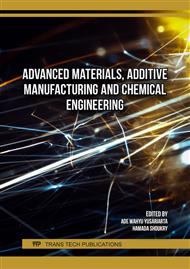p.47
p.63
p.79
p.91
p.103
p.117
p.123
p.131
p.141
Analysis of Hardfacing Direction on Mechanical Properties by SMAW Method
Abstract:
Welding in general is a production process of joining metals that is carried out in a hot state. One of the welding developments in additive manufacturing is hardfacing. Hardfacing is one of the efforts that can be made to improve the mechanical properties and wear resistance of materials that allow them to be used in all conditions. Some of the problems found in ship companies, especially on ship hulls, are a decrease in mechanical properties and wear due to external factors such as damage to the hull due to waves. This research was conducted to determine the amount of mechanical properties produced in welding using the hardfacing process. In this study, the hardfacing method is used as the addition of weld metal to ASTM A36 plates using the SMAW welding method with angle variations. Furthermore, it will be analyzed by tensile testing to determine the tensile strength of the test specimen. In the process, material with a thickness of 5 mm is then welded by the SMAW method to the hardfacing process steel plate using a 3.2 mm E7018 electrode with the addition of 5 mm weld metal. The results obtained from tensile testing with high mechanical properties are found at the highest angle variation with good tensile test results and continue to increase from the lowest angle variation. This research can produce materials that can be used in companies as new materials with high mechanical properties.
Info:
Periodical:
Pages:
117-121
Citation:
Online since:
August 2025
Keywords:
Price:
Сopyright:
© 2025 Trans Tech Publications Ltd. All Rights Reserved
Share:
Citation:


